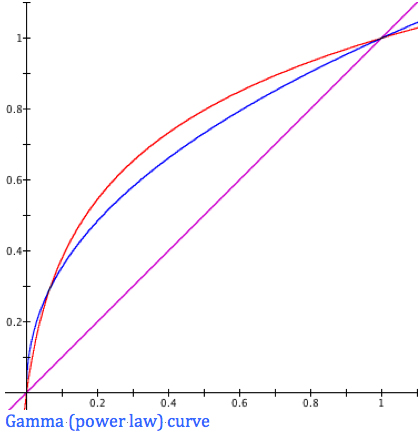Brightness is captured on a Linear scale (LIN), and usually stored with video gamma (REC709) or with a more film-like Logarithmic encoding (LOG). What does this mean, how does one use it, and what capabilities does it represent?
If you've ever taken light readings with a light meter set to foot candles, you're familiar with film's non-linear response to light. In order to increase exposure by one stop, the amount of light hitting the film needs to be doubled. The fact that we perceive a one stop increase in exposure as a linear increase, whether it is a gain over something relatively dark or relatively bright, indicates that our own perception also operates in a non-linear way, similar to film. This response can be closely approximated by a logarithmic function (LOG).
When film is transferred to video, there are two approaches. One is to color correct during the transfer so that the material looks as intended on a video monitor. This footage would have video gamma applied to it. The other method is to capture the full range of the negative for later color correction. This is done using a transfer function developed by Kodak for the Cineon system. It is based on a logarithmic function so that the same numerical interval represents the same change in exposure no matter where on the exposure curve it happens.

LOG Curve
If power law curves and logarithmic curves are so similar, what is the difference? Primarily one of intent. When footage is transferred with video gamma, it is meant for display (perhaps with minor adjustment applied later). When footage is transferred using the LOG CINEON curve, no artistic interpretation of the footage happens during the transfer -- the goal is to preserve the full range of possibilities for later adjustment. This footage will look very flat and dull when displayed directly on a monitor.
The approaches used for film transfer are now choices available for Digital Cinema. Most Digital Cinema cameras have a mode of recording or transcoding to a LOG curve. For example, Sony has S-Log (in the F35, F23, SRW-9000 and the PMW-F3), ARRI has LOG-C, RED has REDLOG, and Panasonic has FILMREC (which, while not technically a LOG curve, serves the same purpose). Each of these LOG curves has been designed to preserve as much information as possible from the sensor and make it easily usable during color correction.
Why Shoot LOG?
There are several advantages to capturing imagery this way. It is simple and predictable both on set and in post. On set there are fewer camera settings with which to be concerned. Color correction can be more predictable because workflows can be optimized for known inputs.
The most significant advantage is the increase in Dynamic Range (captured variation in scene brightness). Because video gamma, such as REC709, is designed to produce pleasing images on the limited Dynamic Range of video monitors, there is a limit to how much scene brightness can be compressed into the signal before the images start to appear artificial or unpleasant. LOG capture modes, because they are designed to preserve image information rather than look good as is, don't suffer from this constraint. The LOG mode instead captures what the camera is capable of discerning. Because the maximum range of sensor data is being recorded at all times, there is more range to create the desired look in post. In a REC709 video gamma, an image may have a bright light source overexpose to white and dark shadow areas record as black. The same image recorded in LOG may have considerable detail on both ends of the exposure range, which in later color correction can be exploited, if so desired.
















